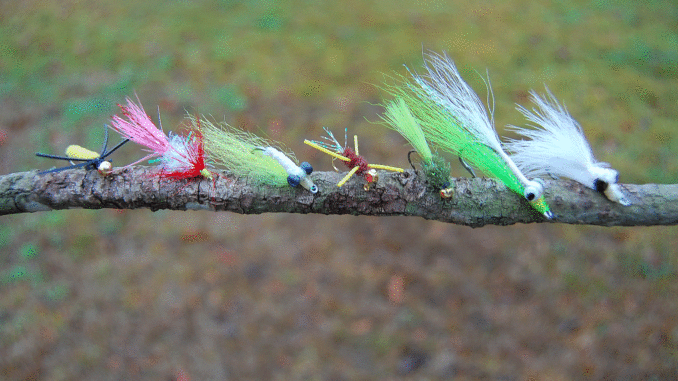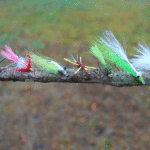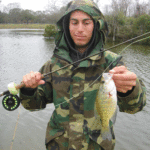
Throw ‘em beadheads, Mister!
Fishing is a lifetime pursuit; one never stops learning. Sometimes the education comes from books, videos or seminars. Sometimes it comes from the kids down the street.
When my wife Lisa and I moved into our house in 1982, I started fishing the subdivision lake on a frequent basis. That’s when I became informed by some of the neighborhood kids that there were some monster crappie lurking in its waters.
I didn’t believe it until I saw the names of two of the kids on the state top 10 crappie list. This was back when the rules weren’t restricted to public waters only.
With a little research, a pool-testing kit and a depthfinder, what I found was that the lake had all the right attributes for great crappie production.
First, it had good calcium carbonate hardness, which in turn, supports a larger food chain. The larger the food chain, the greater the carrying capacity of the pond. In a nutshell, more, bigger fish!
Second, it had “bathometric diversity.” Lots of contours and good depth. Exactly the kind of home a fish dreams about.
Third, there was plenty structure. Each year after New Years, a couple of the resident bass anglers would round up discarded Christmas trees. They’d stand the trunks in plant pots, pour concrete at the base and let them harden. Then haul them by bateau to various spots across the pond and dump them off.
You could tell this was fertile water. It had that gorgeous clear-green color. As we all know from Cormier’s 2nd Law of Fly Fishing, “Clear water favors the fly angler.”
And so this is where I really cut my teeth into fly fishing. Countless bass and bream in that lake contributed to my development as a fly angler.
Anxious to add sac-a-lait to that list, I again consulted my youthful bank-fishing companions. The word was that the slabs were most active in February. That was good to hear, as there were holidays like Mardi Gras and Washington’s birthday (now President’s Day) to add to the weekend opportunities.
Before the local fly fishing club formed, the only flies I even tried for crappie were soft hackles. I’d let them sink down, then strip back in really slowly. They worked OK, but not even close to the success of a spinning rod with a Beetle Spin or twist-tail jig.
At one of the first meetings of the Red Stick Fly Fishers, I met Mark Hester, who was a crappie addict. He knew the sac-a-lait better than they knew themselves! Hester would go on to create the Fluff Butt, one of the most recognized crappie flies in the world. He also was one of the first in the United States to tie flies with beadheads.
Hester’s suggestion to me was to fish weighted flies, either “straight” or under a strike indicator. I took his suggestion and tied up a wet fly with lead wire body.
How good was his advice? Let’s just say it started a tradition in the Cormier household — the “President’s Day Sac-a-lait Feast.”
When beadheads were added to the flies, it greatly improved crappie catches. The same can be said of using small bronze dumbbell eyes, such as 1/120-ounce, or tying flies on small jighead hooks, sized 1/128 or 1/100-ounce. They all work to get the fly down to where the fish are suspended. They also act to pivot the fly, such that any stripping action gives it a bit more lifelike action.
If you’re digging through a bin of flies at your local fly shop, look for the ones with beadheads and either rabbit hair, soft hackle, craft fur, bucktail or marabou for wings or tail. These materials undulate with the pivot motion provided by the weighted head.
Today there are numerous websites and YouTube videos offering tying instructions for a wide variety of panfish flies, most of which are excellent for sac-a-lait. And here’s something to be proud of — many have been created by Louisiana tiers.
I suggest looking these up: Fluff Butt, Beadhead Woolybugger, Cajun Tickler, Micro-Jig, WarmFly, Black Boudreaux, Clouser Minnow, Crappie Candy, Squirrely, Cap Spider, Cat’s Whisker, Harry Fodder, Tom Nixon Spinner.
Finally, one thing I learned from my “experimental station” located conveniently a couple blocks from the house is that when fishing structure, a weighted fly suspended 30 inches or more under a tiny float is your best bet for success. Twitch the float ever so gently, like you would be fishing a floating spider. If there’s a ripple on the water, the fly underneath will skip up-and-down.
Sac-a-lait, your day is coming!
Tippets
It has been a great winter so far for redfish in the deep marsh. On calm days, the water is very clear and the reds, drum and sheepshead are waving their tails in skinny water. If you cast a weighted fly and it spooks the fish, switch to an unweighted one. Small crab patterns, spoon flies, even bonefish bitters will catch all three species.
Bull reds are now a winter fixture in the Biloxi Marsh and lower portions of Barataria and Terrebonne estuaries. They can be found on the edges of lakes, and in shallow water on the backside of barrier islands. Here larger flies like the Redchaser, Whitlock Baitfish, Haleys Comet, EP Peanut and Seaducer are good choices.
This is the best month for crappie action statewide. Some of the best spots to catch them on flies are Bayou Black, Bayou Corne, Blind River, Tchefuncte River, canals off Des Allemands, Lakes Sibley, Kincaid, Nantachie, Vernon and Anacoco. On most days, casting and stripping a weighted fly along tree lines will work. If not, add a strike indicator and cast close to any structure and twitch it slowly.
Based on the catch rates that East Baton Rouge Recreation (BREC) has been compiling on rainbeaux trout in their ponds, there should be plenty of them left this month in Zachary Park. The best fly has been a size 12 beadhead woolybugger. Members of the Shreveport and Natchitoches fly fishing clubs have been having good success on the Little Missouri River in southern Arkansas. The fly of choice has also been the woolybugger.
Upcoming Events
Feb. 11 — Fly Tying Class, Ascension Parish Library, 708 South Irma Blvd, Gonzales. Time: 9 a.m. to Noon. No cost. Basics of tying fresh and saltwater flies. For more info, call Darrell Crawford at (225) 644-7989.
Feb. 18-19 — 10th annual Little Mo Fly Fishing Fest, Community Hall, Murfreesboro, Ark. Time: Saturday 9 a.m. to 7 p.m., Sunday casting workshop TBA. Fly tying, seminars, casting, food, door prizes, and refreshments. $5 admission. Sponsored by Friends of the Little Missouri River. Website: http://www.littlemissouriflyfishing.com/.
Feb. 25 — 25th annual Acadiana Fly Fishers Conclave, Grace Presbyterian Church Hall, 415 Roselawn Blvd, Lafayette. Time: 9 a.m. to 5 p.m. Free admission. Seminars, fly tying, casting, raffles, food and refreshments. Special guest: Cameron Mortenson. Sponsored by the Acadiana Fly Rodders. Website: acadianafly.blogspot.com.
March 3 — 21st annual Red Stick Day Conclave, LDWF Waddill Outdoors Center, 4141 North Flannery Rd, Baton Rouge. Time: 8:30 a.m.-4:00 p.m. Free admission. Programs, fly tying, casting, kayak demos, pond fishing, raffles, food and refreshments. Sponsored by the Red Stick Fly Fishers. Website: http://www.rsff.org/.




